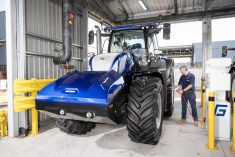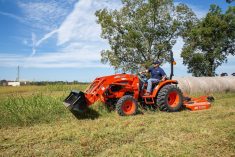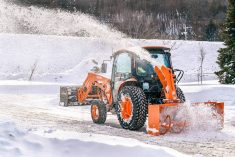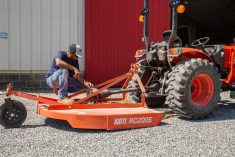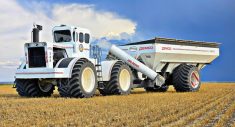After Buhler Industries took over the original Versatile assembly plant in Winnipeg from New Holland in 2000, tractors sporting the Versatile brand name once again appeared on the market. Although the company inherited the four-wheel drive and Genesis tractor line along with the Winnipeg factory, both lines were dated and needed upgrades. High and very-high horsepower tractors were the bread and butter of the Versatile brand, so it’s not surprising the first two redesign projects at the company were focused there. However, in 2013, the company realized it no longer had a presence at the lower end of the high-horsepower market and it set about correcting that.
Read Also

Claas brings 1000 Series SP forage harvesters to Canada
In mid-August, Claas unveiled its new line of Jaguar forage harvesters at an event in Visalia, California, deep in the heart of that state’s dairy region.
“With the Genesis tractor, we kind of concentrated on the high end,” says Grant Adolph, chief operating officer at Buhler Industries, the parent company of the Versatile brand. “Because of emissions, we had to go up in size and we focused on the higher horsepower. Emissions (systems) require bigger cooling packages. Those had a long frame with the cooling package out in front of the front axle. They started at (275) horsepower and went up from there. Then we started looking at how do we expand the line (into the lower horsepower range). Knowing the background on our Genesis tractor, our dealers said that is something they were definitely interested in, basically filling in at the low end of the Genesis or the Range Two as we called it (internally). That’s where it started.”

In 2013, the Nemesis project, although not yet officially named at that point, began. Engineers and executives at Versatile began looking for the right design that would appeal to North American producers as well as European farmers, offering the broadest possible market appeal. But key was providing a tractor that would appeal to the North American row-crop market. From there it was a matter of assembling the right components to build it.
“We needed to be able to develop a tractor that could be used in row crop,” says Adolph. “Obviously a tractor that would be used in feed lots, so it needed front-end loader capability, and also it would be used as a general-purpose tractor — it could be used on a grain farm, or cutting and baling hay. That put a requirement that we had to have a front PTO and three-point hitch on this tractor.
“We started laying out this framework working with the engine manufacturer Cummins, looking at Tier IV Final engines. We found out the after-treatment package was not something that would fit into this tractor. With the after-treatment going under the hood means you had a very wide rear hood with no good visibility to the front axle, which we know in row-crop applications is very important. Cummins told us that when Stage V (emissions regulations) comes into existence, they were going to put all of the after-treatment into one stack in the muffler as one piece. That started tying into, okay, now we can shrink the hood back down and have that visibility for row-crop applications.”
With an engine that would fit the overall design, the next step was to mate it to a transaxle.

“One of the first ones we contacted was ZF,” Adolph recalls. (ZF is a Germany-based transmission manufacturer.) “Which had a smaller version of a transaxle they were working on but needed someone to work with to build a larger version. They had a 170 to 200 horsepower (transaxle) with a CVT and they selected us to work with them on its development. The powershift they had. The rear axle they had. But this would be a brand new CVT transmission. We were the lead company they selected on this.”
The initial Nemesis (and Kubota M8) model release in 2019 was limited to models using the existing ZF powershift transmission. The CVT models are still in field trials and are expected to begin production in the fall of 2020.
Designers knew a suspended front axle option would be essential in order to offer a 50 kilometres per hour-capable tractor, so they looked at what both Carraro and Dana (axle manufacturers) had to offer.
“We found out Dana was much further ahead and actually had a suspended axle they were developing for CNH on basically the same size tractor,” Adolph continues. “We were putting the pieces together. With a supplier for an engine, transmission and axles, we had to develop a frame. We designed it to be capable of having loader mounts built in and could have a front three-point hitch attached to it. We started integrating the design.”
With the chassis taking shape, engineers turned their attention to the operator station, however, simply recycling one from the smaller models of the previous Genesis line was no longer an option.

“The Genesis cab was outdated,” Adolph says. “We looked at the cab we had on the higher horsepower row-crop model and the four-wheel drive. That was a bit big for this tractor and didn’t have some of the features we were looking for. We worked with a cab supplier (U.S.-based Crenlo) and put together the pieces for a new cab that had left- and right-hand doors. Because you have a loader, ideally you need visibility for a high-reach loader, so you have to have a sunroof.”
Although there was significant input on cab design from specialist Crenlo, the intent was to eventually have the cabs assembled in-house at Versatile’s Winnipeg plant.
“On the control side, obviously with electronic control tractors, you need an armrest mounted to the seat, which includes features for a multifunction lever, that includes transmission, three-point hitch, hydraulic controls and other features. So, we worked with a company to develop a unique armrest,” adds Adolph.
With all of that engineering handled, there was still one complication not all that typical in the industry in recent years, the tractor line was to be built wearing two different brands: Versatile and Kubota. That required joint efforts and agreement between management and engineering staff from both. And although they’ll share the same basic platform, there will be some differences, aside from the colour, between the two versions. Most notably, the armrest and the digital components inside the cab of production tractors will see some variations. Unlike the Versatile Nemesis, the Kubota M8 version will use an armrest monitor and digital package similar to what is already used in the smaller M7 line, which will keep the operating experience similar between those two within that brand.

Once the power shift versions of the tractors had completed field trials and were given a thumbs-up by engineers and management at both Versatile and Kubota, next came the task of arranging their introduction to the general public. And, you may be wondering, how exactly did the same tractor line end up wearing two brand names? We’ll take a look at both of these things in the next instalment.




